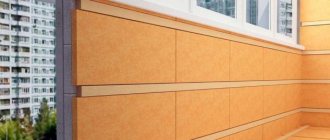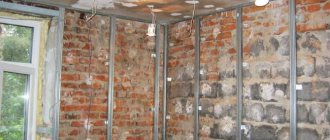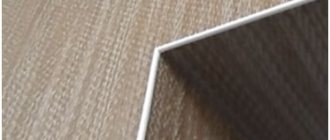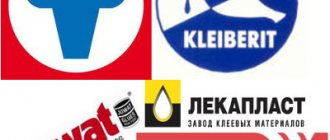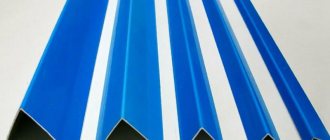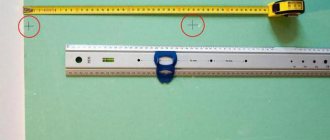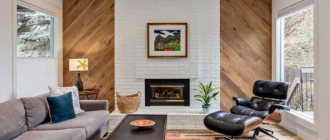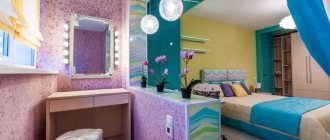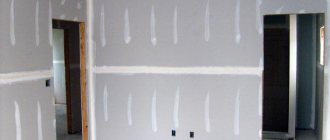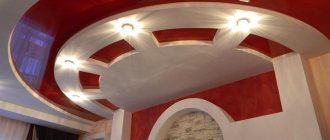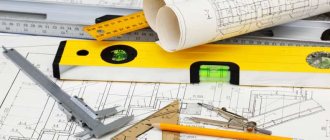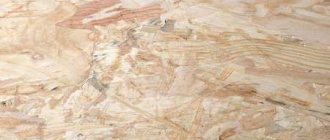During the renovation process, most wall cladding problems are associated with their uneven surface. This problem can be solved in two ways - leveling with plastering or plasterboard construction. Constructing a plasterboard structure using profiles is a very labor-intensive method that requires certain experience, skills and the availability of construction tools. However, it is possible to cover the wall with plasterboard without these profiles - by gluing it. There are several methods for gluing drywall to a wall, so let’s look at all their nuances and advantages.
When are gypsum board adhesives used?
Gluing drywall is permissible if at least one of the following conditions is present:
- The slopes need to be trimmed. Their lining is also important.
- Connection to the ceiling. But here it is worth remembering about self-tapping screws.
- Irregularities on the walls up to 5 centimeters.
- Small rooms in which it is important to save literally every free centimeter of space.
The frameless method should be abandoned if we are talking about serious areas and uneven areas. Otherwise, gypsum board glue will not help.
Preparing the walls
- To choose the method of wall cladding, it is necessary to determine the curvature of the walls using a water level or plumb line.
- Protruding nails, screws, etc. are removed from the wall.
- The base is cleaned from the remnants of the old cladding to clean brick or concrete.
- The wall is cleaned of dirt and primed to increase adhesion.
- Lines are drawn on the floor along which the position of the sheets will be adjusted. In case of strong curvature, lines are also drawn on the ceiling, which will ensure high-quality installation of the sheets in the same plane.
Moisture-absorbent materials are coated with an agent that reduces absorption.
What adhesive for drywall should I choose?
Many craftsmen prefer to experiment when gluing drywall. It includes the use of starting and finishing putties together with tile adhesive based on a cement binder. Other repairmen learn to connect sheets even with metal and wood bases, using polyurethane gypsum glue for this purpose.
| Material | Descriptions |
| Primer composition | The walls are treated with it before starting work to strengthen the base and better adhesion to the leveling sheets. |
| Glue | As a rule, a gypsum adhesive composition is selected. The main criteria that you need to pay attention to when purchasing will be discussed below. |
| Plasterboard sheets | They are selected depending on the purpose - wall (12.5 mm) or ceiling (9.5 mm). Products are also available in regular (gray on the front side), moisture-resistant (green) or fire-resistant (pink). |
On the modern market it is easy to find a fairly reliable and inexpensive variety of compositions made from gypsum and more. Regular and moisture-resistant cardboard go well with dry gypsum mixtures.
They can be used in different places indoors, with the exception of swimming pools and other similar objects. Including when creating a good partition.
Putty can be chosen in the case of a flat base. The main thing is to figure out in advance how to glue drywall to the wall.
A deep-penetrating composition is required in the case of priming highly absorbent materials. A smooth, hard surface requires primers with acrylic resins and quartz sand. Drywall sits on glue quite quickly.
Ceiling finishing
The base must satisfy the following conditions.
- Not made of wood. You cannot stick it on a wooden base, since the material can change its size, which will cause the sheets to quickly fall off.
- The base is level. If it is difficult to make a perfectly flat ceiling, you can level it with plasterboard beacons. The guides glued in advance will serve as a leveled frame.
- The concrete ceiling should have notches for better adhesion.
- There should be no condensation on the ceiling, it should not freeze or become damp. If the apartment is regularly flooded from above, this finishing method is not suitable.
- There are no greasy stains, the ceiling is not painted with oil paint. The base must be cleared of elements poorly fixed to it.
For the ceiling, plasterboard of minimal thickness and Perlfix glue are selected.
You can prepare a homemade composition from alabaster (58%) and bone glue (2%), diluted with water (40%).
First, the evenness of the ceiling is checked, and areas of strong differences are tapped with a mallet. To avoid the formation of cross seams, it is better to paste the ceiling in a checkerboard pattern. When gluing near door or window openings, the entire surface of the drywall is coated.
How to glue drywall to brick, gas and foam concrete
In this case, several main options remain relevant:
- Dowel-nails.
- Self-tapping screws.
- Polyurethane foam.
- Glue installation.
Humidity and the curvature of the walls affect how to glue drywall in a particular case.
Concrete walls are in most cases smooth, so they use compounds with a cement base. Special notches are created on the wall to increase adhesion. Fixation of the gypsum board occurs after the primer is distributed over the surface. Any master can easily figure out how to glue and how to attach materials.
Another thing is on a brick wall. The facing material is usually fixed to the wall with your own hands using polyurethane foam. It is easier to control the amount of product applied if you choose a “snake” pattern. You should wait a few minutes after applying the first coat. When expansion begins, a sheet is applied to the wall. All that remains is to level it out. The mounting adhesive holds everything in place well.
Foam for installing polystyrene foam will be an excellent solution in the case of brick walls. Its main difference from its analogues is that it is not such a serious expansion. Anyone can figure out how to glue drywall.
Peculiarities
A universal building material - plasterboard - allows you to independently level walls, mount an interior partition and much more for little money and in a short time.
A sheet of drywall consists of two layers of cardboard glued together with a layer of gypsum. Standard sheet size is 2500x1200x12.5 mm. Such a sheet has an area of 3 square meters and weighs about 30 kg. You can find drywall in other sizes on sale. In practice, two options for fastening plasterboard sheets are used:
- using a steel profile;
- using special glue.
The first method involves installing a special metal structure for further fastening of plasterboard boards. This requires additional financial costs, as well as at least minimal installation skills.
To work with the second method, it is important to know how to glue the slab to the wall. Gluing plasterboard sheets can be done on any wall surface, you just need to remember that plasterboard is basically paper (albeit quite hard), and like any paper, it is afraid of moisture. Therefore, drywall is intended only for interior decoration.
What adhesive compositions are required for concrete floors?
It is rare to find monolithic walls with obvious and serious deficiencies that occupy a significant area. The sticker does not cause problems in most cases.
You can choose any variety of materials to install drywall with glue:
- Polyurethane foam.
- Polyurethane adhesive.
- Cement adhesive that helps to adhere tiles.
- Acrylic types of putties.
- Plaster putties.
- Gypsum adhesive, which is originally intended for plasterboard sheets.
For all these compositions, the size of the seams will be minimal, while the connection between the materials will be as strong as possible. Installing drywall with glue is as simple as possible.
“Betonkontakt” also has good characteristics. This is a type of primer with acrylic polymers and quartz filler. The presence of special additives and additives in the composition guarantees reliable adhesion to any surfaces, even the most difficult and dusty ones. You can glue drywall with another type of glue.
When the base is polystyrene foam
These materials are great for protecting your home from the cold. But they require the use of drywall to prevent the appearance of defects during operation. The use of polystyrene foam is selected from 5 and even 10% of the usable area of the room. An additional metal profile with plasterboard increases the loss of space. Therefore, gypsum board becomes the optimal solution.
Acrylic putties and adhesive foam do an excellent job with their assigned functions. The instructions help you figure out how to properly glue the material.
GCL and gypsum fiber
Sometimes it is necessary to glue plasterboard onto sheets of almost the same similar material. Such bases are completely devoid of irregularities, therefore it is permissible to use any compositions in which the seam size is minimal. For example, silicone sealants, liquid nails or acrylic putties are suitable for gluing drywall.
You can replace them with gypsum and cement compounds for gluing, or foam. But when using them, the thickness of the seam increases, and the free space of the room decreases.
Marking
With the adhesive installation method, plasterboard sheets are usually installed vertically, which must be taken into account when marking the internal space. This is true for apartments with standard wall heights - one sheet 2.5 m long is just enough to cover the space from floor to ceiling. If we are talking about “Stalin” buildings or private houses, where the wall height often exceeds 3 meters, this rule does not work, so the sheets can be installed horizontally. The marking is carried out in such a way as to minimize the number of joints and symmetrically glue entire gypsum boards.
If the installation of drywall is carried out for the purpose of leveling the walls, you need to do the following:
- find the two most prominent areas and draw a line between them;
- retreat a distance equal to the thickness of the sheet from the first line and make a control mark;
- Using a building level or plumb line, transfer both lines to the ceiling.
Technology for installing gypsum boards on glue
You can begin installation immediately after selecting the optimal type of composition. There are three main methods that are suitable for those who are interested in how to glue drywall to a wall.
Option 1 for flat walls
The method is combined with surfaces that do not have significant differences. Usually we are talking about plastered or concrete surfaces on which gypsum boards are installed.
- Wall chipping.
- Cables are secured in the resulting grooves.
- Create holes where sockets and switches will be placed.
- The primer is distributed over a surface that is completely free of dust. If the composition does not stick and the wall is painted, you can solve the problem of gluing drywall by choosing options with quartz fillers.
- All that remains is to cut holes to accommodate the electrical equipment.
Tools
Speaking about the set of tools required for work, it is worth noting that it is much smaller when choosing the option of gluing gypsum cardboard to wall panels.
For frame plantings, much more is required.
So, you will need:
- Drill to speed up the process of kneading the adhesive mass with a mixing attachment. Thanks to it, the composition is much more homogeneous with better characteristics. Although, if you wish, you can even do without it;
- Long construction level. You can also use the rule, which is very convenient to control the overall plane along with how straight the sheets are located along the walls or ceiling;
- The list is completed by a small-sized trowel (spatula), adapted for uniform application of the adhesive mass to the surface, along with a well-cleaned container where the adhesive mass will be mixed.
Additional tips from experts
Puttying of joints usually begins 2-3 days after applying the adhesive composition to the surface. Then you can be completely sure that everything is dry. For leveling, putty is used, then reinforcing tapes are pressed into it.
After drying, use another layer of putty on the joints and on protruding nail heads, if they were used during the repair. Anyone can quickly figure out how to properly glue drywall to a wall.
Gaps along the floor may be sealed with any type of suitable sealant. Finishing work begins only when the joints are completely dry.
It is better to complete all work with electrical wiring before the walls are leveled. What kind of work will be done is decided separately in each case.
Drywall is prohibited from being glued to lime plaster. It is easy to find the answer to the question of whether this can be done.
The sheets are glued only to a supporting base, which does not crumble or delaminate.
Dowels increase strength if necessary. Use 4-5 pieces per slab. This is the right kind of proportions.
It is better to gluing when the ambient temperature reaches +10 degrees.
Drywall is left in the room for two to three days in advance. This makes acclimatization easier. Materials will be fixed better, even if the base is uneven.
GKL sheets are cut in such a way that there is a gap of about 10 mm at the bottom. Then the material will have additional protection from absorbing moisture from the floor.
Even on the same wall, you can use several different mounting options at the same time. Leveling walls with plasterboard using glue is the simplest process possible.
What else should you pay attention to?
It is recommended to dilute the glue for 30-40 minutes of work, because all residues tend to harden. After dilution, the material is allowed to sit for at least 3-5 minutes. If you apply everything at once, the quality of work will be much worse. The question of how to glue drywall together deserves special consideration.
There are mixtures that are prepared independently. Here's an example recipe:
- 4 parts plaster.
- A solution of any construction adhesive. 1 liter of water is used per 25 grams of dry mixture.
- 1 part sawdust.
It takes an hour to an hour and a half to glue the plasterboard onto the wall, depending on the thickness. Then everything comes together after a while.
Special compositions for gypsum boards and surfaces with small differences in height are produced in finished form. They are packaged in cans of up to 0.75 liters. One of these is enough for about 15 square meters of room area. The gluing proceeds evenly.
When preparing it yourself, sometimes you use PVA glue and gypsum putty. The main thing is that its consistency is similar to sour cream. Mix such plasterboard compositions until completely homogeneous. Leave it for at least five minutes before use.
The most popular material is definitely the series from the manufacturer KNAUF. They are easy to use for interior finishing of most surfaces. When glued, this material provides many advantages. For example, use for uneven surfaces and the presence of only environmentally friendly components.
You can often find the type of adhesive composition “VOLMA-Montazh”. This is gypsum, with which mineral additives are used. The manufacturer guarantees adhesion and simplified preparation of the final product. Finishing walls with plasterboard will delight you for a long time.
Cladding with plasterboard sheets: advantages
Facing with HA sheets is carried out in the following cases:
- surface leveling;
- improved heat and sound insulation;
- hide wires and pipes;
- surface decoration - creating niches, shelves, design with figured elements.
The plasterboard sheet has a flat surface; when mounted on a wall, it does not deform, but remains flat. This is convenient for subsequent painting, laying tiles, and wallpapering.
In various rooms with high humidity and high temperatures, the following types of gypsum boards are used:
- An ordinary room with moderate temperature changes is a gray gypsum board sheet.
- Wet room: bathroom, corridor in a private house, balcony, attic, kitchen - green sheet of plasterboard.
- A room with a working fireplace, a Russian stove, with a rough stove - pink gypsum board.
On the construction market there are types of floor plasterboard and facade plasterboard for outdoor work.
There are methods for attaching sheets to the surface - frame and without frame. In the first case, profiles are applicable. For the second method, you need to choose the right adhesive composition.
Advantages of gluing gypsum board to the surface:
- installation is easy and quick;
- less expensive method compared to frame;
- this method does not take away extra centimeters.
The negative side is the inability to hide wires and communications behind the casing.
We recommend: Cleaning the chimney: how to clean the chimney from soot using folk and modern methods
